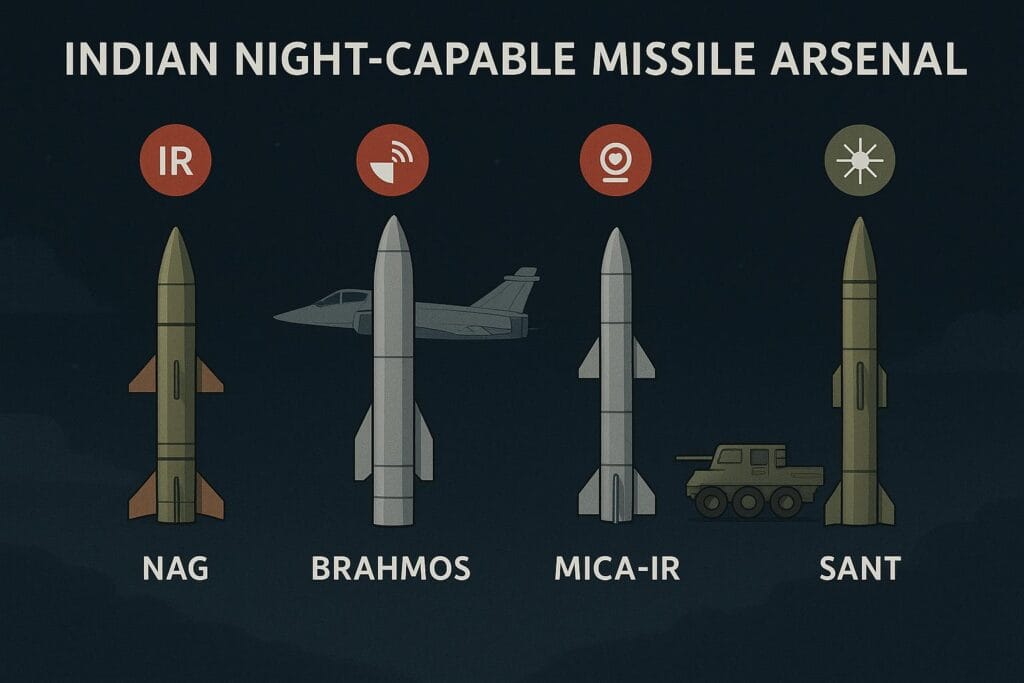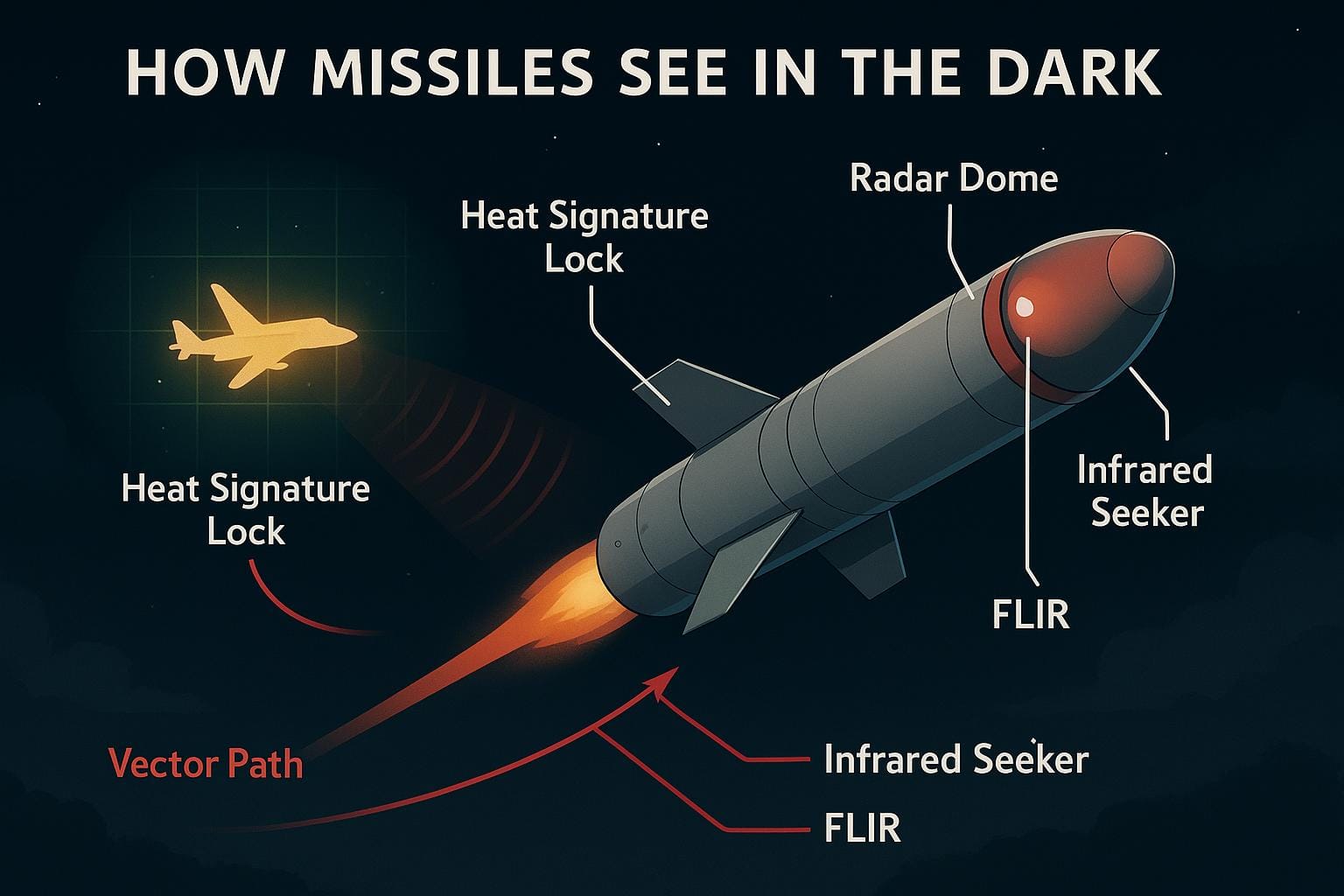Modern warfare doesn’t stop when the sun goes down. Whether it’s a dogfight in the sky or a strategic missile strike at night, accuracy and visibility remain paramount. But how do missiles “see” in total darkness? This post dives deep into the science of night-time missile guidance, highlights missiles used by the Indian Air Force, such as those mounted on the Rafale fighter jets, and explores India’s missile manufacturing ecosystem.
1. The Science: How Do Missiles Navigate and Hit Targets at Night?
Missiles operate in complex and dynamic environments, especially in nocturnal or obscured conditions. Several core technologies enable these “smart” weapons to see in the dark:
A. Infrared (IR) Imaging and FLIR (Forward-Looking Infrared)
- Missiles use infrared seekers to detect heat signatures of targets — typically jet engines, fuel exhausts, or even the thermal imprint of vehicles.
- FLIR systems are particularly useful in low-light and no-light environments, scanning forward from the missile’s nose to capture heat maps.
For example, the MBDA MICA-IR missile used on the Rafale jets has an infrared homing seeker that can lock onto a target’s heat signature, even in pitch black.
B. Millimeter-Wave Radar (MMW)
- These radars emit high-frequency waves (30–300 GHz) that can penetrate fog, smoke, dust, and darkness.
- Used in all-weather missiles like the Hellfire AGM-114L, MMW radar enables terminal homing and target recognition.
C. Image-Based Terminal Guidance (IIR)
- Imaging Infrared seekers capture a 2D image of the target and compare it with stored profiles.
- The missile then matches the target’s image with its internal database, allowing for precise strikes — day or night.
D. Laser Guidance Systems
- Used in precision-guided munitions like the DRDO-developed SANT missile, a laser designator illuminates the target which the missile follows.
- Requires coordination between the launcher and another laser-equipped source (e.g., UAV or soldier).
2. Rafale and Night-Capable Missiles Used by India
A. Rafale Fighter Jet: India’s Night Strike Powerhouse
India’s Dassault Rafale fighter aircraft are fitted with an advanced Thales Spectra EW system, RBE2 AESA radar, and Infrared Search and Track (IRST) capabilities. This allows Rafale to engage in:
- Beyond Visual Range (BVR) combat
- Night-time air superiority missions
- Precision strikes in low-visibility conditions
B. Missiles Deployed on the Rafale
| Missile | Type | Night Capability | Description |
|---|---|---|---|
| MICA-IR | Air-to-Air | Yes (IR seeker) | Lock-on after launch, uses infrared imaging. |
| SCALP-EG | Cruise Missile | Yes (GPS + IIR) | Long-range, stealthy, image-guided cruise missile. |
| Meteor | Air-to-Air | Partial (Radar guided) | Active radar seeker with BVR targeting. |
3. Indigenous Missiles with Night-Strike Capabilities
India’s missile development, largely led by the Defence Research and Development Organisation (DRDO), includes systems capable of operating in night and adverse conditions.
A. BrahMos Missile
- Type: Supersonic cruise missile
- Guidance: INS + GPS + radar seeker
- Night Capability: Yes (radar and INS-based targeting)
B. Nag Missile
- Type: Anti-tank guided missile (ATGM)
- Night Capability: Yes (Imaging Infrared seeker)
- Developed by: DRDO
- Deployed with NAMICA carrier and designed for all-weather operations.
C. SANT Missile
- Type: Air-to-surface missile
- Night Capability: Yes (MMW radar and laser guidance)
- A next-gen upgrade of HELINA/Nag with extended range and dual guidance.
4. Indian Missile Manufacturing Ecosystem
India’s missile development ecosystem is a blend of public-sector research, state-owned manufacturing, and increasing private-sector participation.
A. Key Players
| Organisation | Role | Notable Projects |
|---|---|---|
| DRDO | R&D | Agni, Prithvi, Nag, Astra |
| Bharat Dynamics Ltd (BDL) | Manufacturing | Akash, Milan, Konkurs, MRSAM |
| Bharat Electronics Ltd (BEL) | Electronics, Seeker Tech | Radar & seeker systems for Akash |
| Larsen & Toubro (L&T) | Private sector integration | BrahMos components, launcher systems |
| Tata Advanced Systems | Components, integration | ATGM systems and subsystems |
5. Comparative Global Technologies
| Country | Night Vision Tech | Example Missile |
|---|---|---|
| USA | MMW + FLIR | Hellfire AGM-114L |
| Russia | IIR Seeker | 9M133 Kornet-EM |
| Israel | Electro-optical + Laser | Spike LR II |
| India | IIR + Laser + MMW | SANT, Nag |
6. Future Outlook: What Lies Ahead?
India is moving toward network-centric warfare, where night-capable missiles are integrated into real-time data-sharing ecosystems using:
- AI-enabled targeting
- Satellite-backed guidance systems
- Swarm missile tactics (ongoing research)

DRDO is also working on Hypersonic Cruise Missiles and Quantum Radar Technology, both of which will redefine future night-time strike capabilities.
Conclusion
The ability of missiles to operate in darkness relies on cutting-edge sensor technology — from infrared seekers to radar-based homing systems. India, leveraging platforms like the Rafale and indigenous missiles such as BrahMos and Nag, is rapidly building a night-strike capable arsenal. As global threats evolve, India’s synergy of scientific R&D, industrial manufacturing, and defense partnerships is crucial in maintaining a strategic edge — even in the dark.
read our other blogs here
want to read more about the topic click here





